Maybe it’s because I’ve been renovating a house for so long now, that my focus lately has switched over more to home design and interiors, rather than fashion. Because between the two, there are so many similarities. As with fashion, home design is about amplifying a unique vision and perspective, refining a viewpoint of the world, and then curating this down until it becomes a focused and considered visual statement.
While receiving endless emails this month on ‘what to buy now’, ‘trends for 2024’ and various shopping wish lists, I’m deluged with a constant stream of information on how to improve the visuals of my life. Yet, I find myself wondering - what if what we needed was actually the opposite of this, and simply nothing?
We are bombarded with the viewpoint of needing more and more, being sold to in our daily lives via Instagram and other social media, more than we have ever experienced before in humanity. Yet this idea that we can buy ourselves into feeling happiness, contentedness or envisioning a new life via what we own, is causing our brains to be hardwired to anxiety, depression and a feeling that we can never be good enough.
I’ve found myself with the realisation, that instead of wanting or needing more, that what I truly need, deep down, is a moment of taking a visual break. Of simply not being influenced by outside forces, and trusting my own unique viewpoint as a guiding force. Which is something that I feel we’re losing the ability to do, with the current onslaught of information.
Clutter in every sense takes away from us. It strips us of the clarity to think and the ability to hone in on the vision for our lives. It takes away our time, and energy, not to mention the detrimental effect of what our excess consumerism is doing to the planet.
To begin this inner process of elimination means fully trusting yourself and beginning to create visual space, literally, and physically. Creating spaces that allow for thought and inspiration, just for yourself. Then to protect those spaces both in your mind, on your screens and in the real world, putting safeguards in place to protect your creative intuition, your brain and inventive creativity.
While minimalism is not the answer for everyone, it can be a starting point for a greater conversation on why we desire the things in our life, and what is motivating us to want them. Where are we finding our points of design or style reference? Are they from ourselves and our life experiences, our aspirations and dreams, or are we being affected by seeing too many similar things day to day and a perceived idea of luxury? Have we lost the ability to critically think for ourselves in the process of convenience? Do we choose what is easy rather than what is right?
“Minimalism is a tool we use to live a meaningful life. There are no rules. Rather, minimalism is simply about stripping away the unnecessary things in your life so you can focus on what’s important”
Joshua Fields Millburn, Minimalism: Live a Meaningful Life
At the end of this post are some questions that you can start to ask yourself, that will get the process of thought rolling, as for now, this is a starting point of an unravelling of ideas. All centered around, what is our true north in life, and how can our homes, lives and style support it? What would life look like with very few distractions?
“Owning less creates an opportunity to live more.”
Joshua Becker, The Minimalist Home
Creating Spaciousness by Needing Less
Here I take a look at several homes that follow this principle, and at the end, I share some thoughts on how to begin the process of practising creating a value-led home.
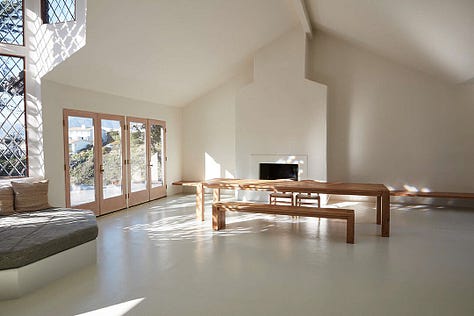
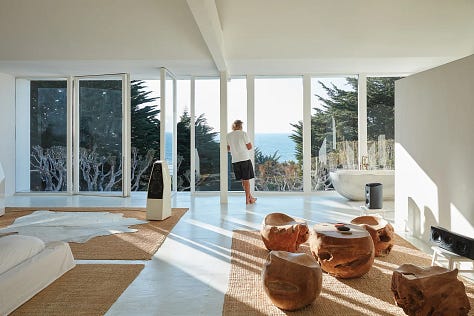
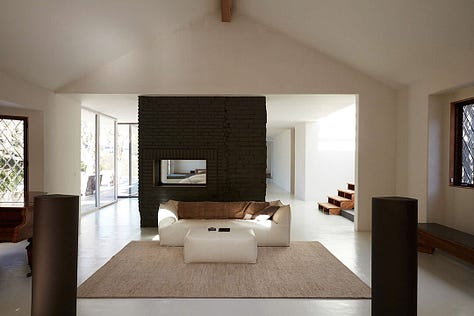
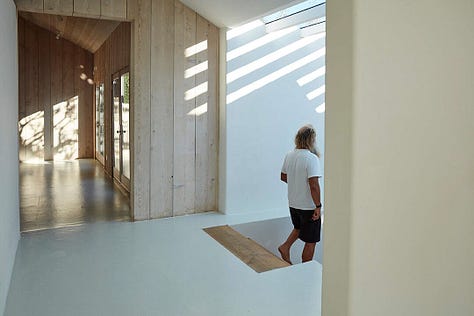
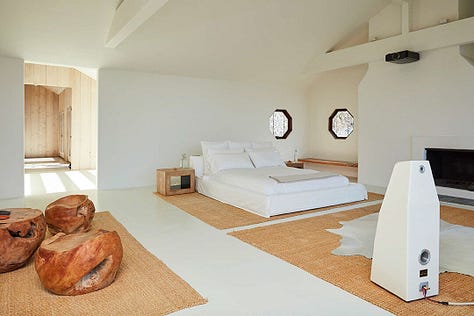
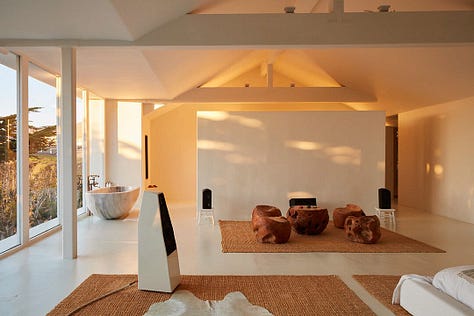
Taking a look at Rick Rubin’s Home designed by Bonetti / Kozerski Architects, we can see that his home represents a bold take on minimalism that roots down to the most important needs and functions of his life - sound. The experience of sound has been amplified in every room, with the rest of the noise of life stripped away and speakers in most of the empty spaces of his home. While this may be too extreme an approach for many people, we can see his values made visible. The way that he lives his life is a mindfully practised art form in living motion. Cutting the clutter means he can focus on his life’s work without the distraction of anything else, and the subtleties of light, muted tones and the zen-like feeling of his home come into focus, without the need for excess decoration.
“The goal is not to fit in. If anything, it’s to amplify the differences, what doesn’t fit, the special characteristics unique to how you see the world. Instead of sounding like others, value your own voice. Develop it.”
Rick Rubin, The Creative Act: A Way of Being
Rick Owen’s Home via Vogue
Rick Owens is known for an unwavering, non-trend-based design aesthetic, which never strays too far from the same dark, layered, monochromatic visuals within his work. We can see how he applies this same brutally stripped-back approach to not only his home but how he lives his life, wearing almost the same clothing every day. Choosing a uniform to simplify his daily choices creates spaciousness in other areas of his life, allowing full focus on his world as a designer and creator. This is often a similar theme that can be found at the higher end of very defined peoples creative life, that subtracting allows complete focus on the job at hand, and often translates itself into stronger, more exciting work.

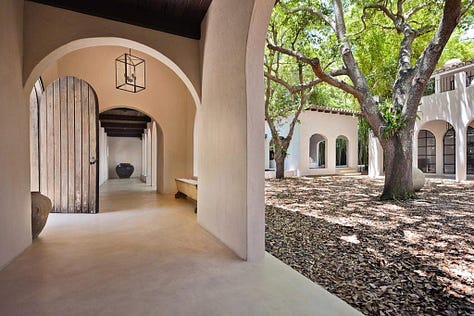
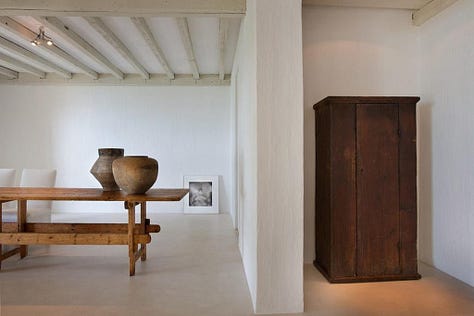
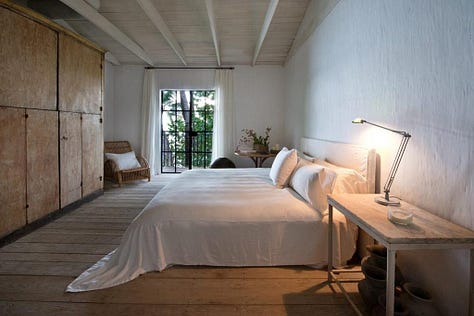
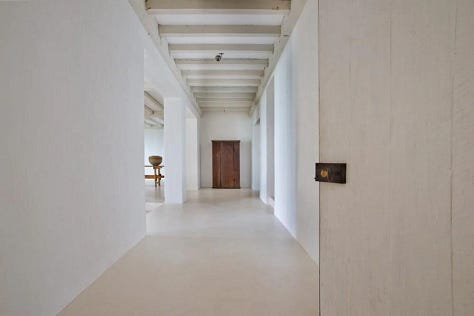
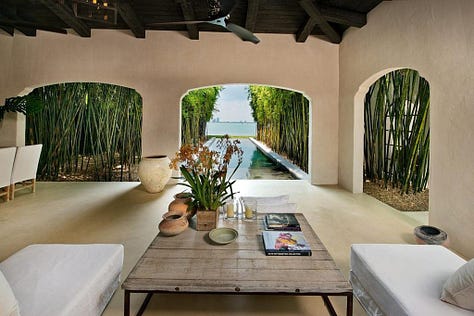
Axel Vervoordt, a Belgian interior designer and antiques dealer, creates homes with a consistently understated and humble approach. Inspired by the restorative concepts of wabi-sabi, appreciating aged patinas and blending natural elements of light, metal, and wood in his interiors. On his website, he states:
Our philosophy is a belief that a home should be a personal expression of your soul. It should represent the way you want to live, the ideas that define your tastes, perspectives, and connections to the world.
There’s a feeling of timelessness, peace and calm throughout all of his designs, with a profound appreciation for the natural world and the passing of time. Because his style is so timeless, past designs look just as modern and relevant today as they did when they were designed back in the early 2000s.
“Nature is our greatest master. They said that I must find a reason for everything that I do and seek to express that reason. They told me never to be decorative - to avoid it at all costs. To be decorative is to do things just to please others, to create beauty for the sake of beauty.”
Axel Vervoordt, Axel Vervoordt: Stories and Reflections
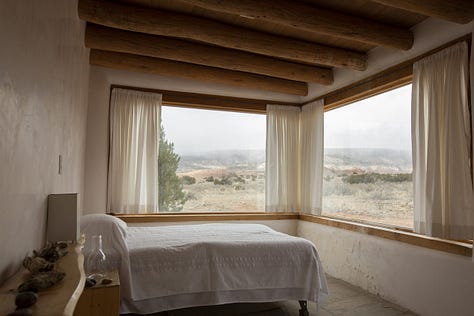
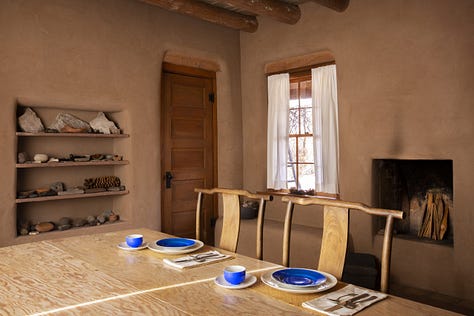
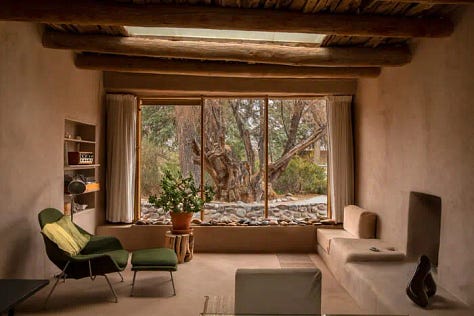
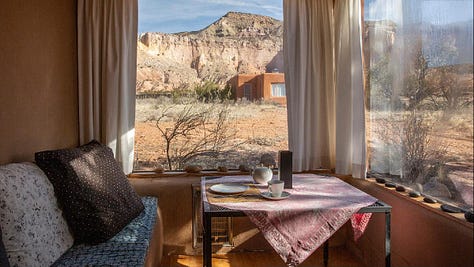
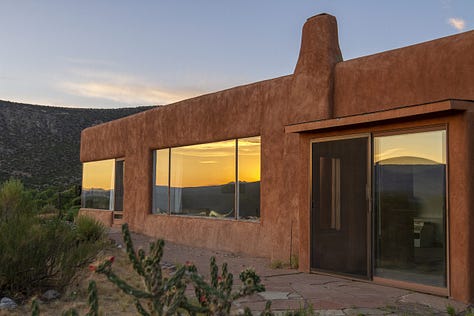
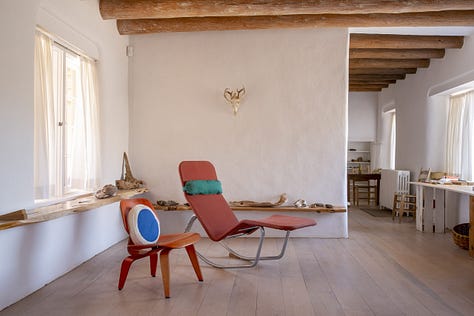
Another home that stands out to me, is Georgia O Keefe’s Ghost Ranch. Previously stood abandoned, and bought by Georgia in 1945, she was inspired by the stark landscape, quietness of the region and the visual richness of the area. The home enabled her to develop her painting style further, creating some of her most famous works in the New Mexico desert.
The dusky, muted and nature-led design of the house and it’s interior, created in collaboration with architect Maria Chabot, do not look at all out of place today despite its age. By working in harmony with the landscape and embracing it’s warm-toned, weathered aspects, the house stands as a reminder that what is original, simple and visually still, will always outlive passing design phases.
“To create one's own world takes courage.”
Georgia O'Keeffe

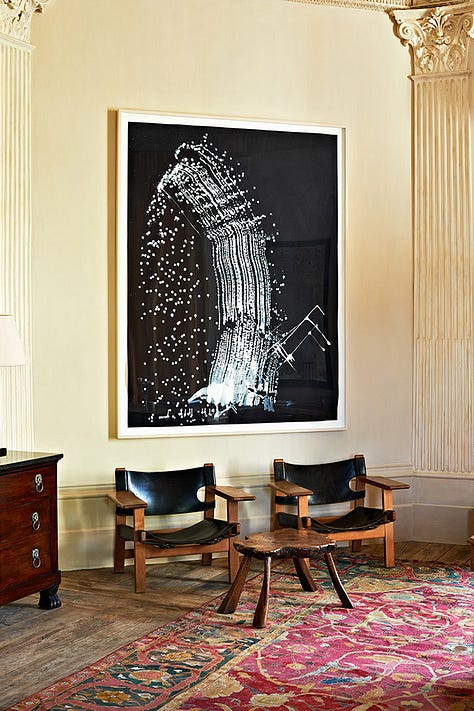
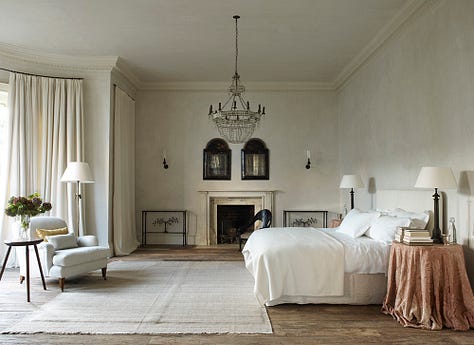
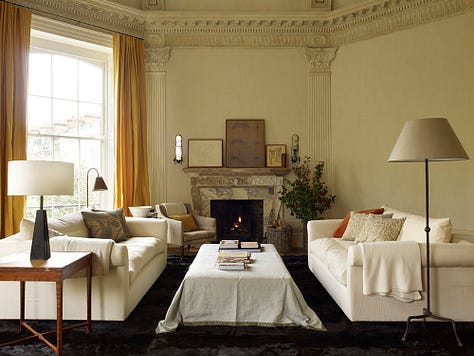
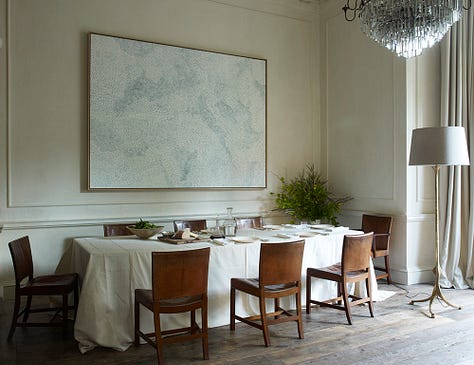

British interior designer, Rose Uniakce’s home has a more typically English style, yet created using hushed tones and a less is more approach. In contrast to the often busy and over-accessorised, cluttered spaces we can see in homes, it’s possible to really appreciate the individual style choices made in Rose’s home. From the stripped back approach to colour and the intentional placing of mainly antique furniture, the statement made is one of tranquility and rest. Not quite minimalism and yet still embracing a classic British style, this merging of several ideas, results in a gentle harmonious home, that’ll long outshine any trends that come and go.
”My style icon is Eugenia Errázuriz, a pioneer of modernism. She was way ahead of her time, stripping grandiosity out of interiors at a time when that was unheard of – and in doing so, she elevated simplicity to an art form”.
Rose Uniakce
Visual clutter, Gaining, by Taking Away
So what can we learn and take away from these homes? Well, we can begin, by simply prioritising what’s important in our lives - via a series of decision-making that we can make daily. We can discover what motivates and moves us to live our most fulfilling and happiest life, and with these findings put in place a new footpath, that will lead us to a more spaciously expansive life.
By taking away the distractions and remaining free of them, we unlock more time, better finances, a renewed sense of purpose in our lives, we live more in harmony with nature and create the space to fill ourselves up with what is actually important to us. Too many meaningless possessions weigh us down and distract us from our life’s purpose, we may momentarily receive a dopamine boost by a new purchase or a new distraction, but deep down it’s taking us further away from our sense of self, which is constantly evolving. By removing the visual clutter, we are able to evolve further, and not putting ourselves at risk of stagnating based on our past choices.
There will always be new trends, shiny new objects and enticing things that would love to see us part with our money and time, but by remaining steadfast to our true sense of self, we can set ourselves up for a lifetime of measured decision-making, that’ll only support us now and into the future.
To get to this point, we need to ask ourselves some difficult questions, that will unearth who we really are, what we value and what is individually important to us.
Unearthing What You Value
Some questions to ask yourself:
What is the most important thing in my life that I want to create or achieve?
What do I value the most in my life? Make a list.
What is my idea of luxury, is it time for yourself, physical possessions, taking trips, time to myself, etc?
What would I want in my life if there were no limits?
What would be my dream way of living?
How closely am I living by my truth?
Who have I seen online that closely lives in a way that I dream of?
If I had to choose only 3 possessions to keep and I had to lose the rest, which would these be and why?
If I could live anywhere in the World, where would it be, and why?
If I only had a year left to live, what would I do, where would I go, and how would I live?
Some of My Small Steps to Prioritise Purpose
Here are some of the steps that I’m taking to move towards a distraction-free life so far, that may prove helpful ideas to get you started on your journey too. You can set your own depending on what’s comfortable for you. This will be an ongoing process, so expect to see more updates and ideas on this soon.
Removing 5 things a day from your home. This is easy to complete, straightforward in concept, and effective, simply stay consistent with it. Just remember to try and recycle or donate as much as possible, so as not to create more unnecessary waste.
If you do buy anything new, remove two more items in its place. This is taking into account, making only mindful, well-considered purchases with the product lifespan and longevity in mind.
Refine your style language to its most basic elements. Identify exactly what it is at the core, that moves you stylistically, looking at tones, hues, shapes, textures, and references. Then make mood boards that you can follow based on these elements.
Start to make style decisions from your values, rather than what catches your eye momentarily. Before you make any new purchases, really ask yourself if you can see yourself owning this item for the next 20+ years, and how you’d repair it if it broke, or is it easily recyclable with a fully traceable life cycle?
When you feel tempted to try incorporating a new trend, sit with it and ask yourself - does this feel authentically like me? Can I see myself liking this next year, and the following? What is it about this trend that excites me? Is this genuine excitement that I feel, or am I fearful of being left behind?
Easing away from social media, then replacing your search for inspiration beyond current culture and your phone. Try incorporating a daily inspiration walk, visiting exhibitions more regularly and seeing artefacts or objects of interest weekly. Determine the thread of similarity that binds your influences, retraining your brain to move away from digital media in the search for inspiration.
Box up the majority of your unused possessions and store these away somewhere safe. Then set a date for a years time, to revisit these and see if you still feel the same way about them. If you need to open the boxes sooner to gain access to something, then this shows you that this particular item is needed. However, you may be surprised by what you no longer miss!
Let me know in the comments how you feel about your home currently and the level of clutter. Did any of these tips resonate with you, and do you plan to incorporate any? Maybe you have some suggestions of your own on this subject?
One thing that I hope to do this year is to continue to support the work of the Worldland Trust, whose work protects and saves the world’s most biologically significant and threatened habitats. The ‘buy an acre’ scheme enables you to directly support their work, by putting the land back into the hands of the local people, the experts in their own land conservation.
Find out more here.




